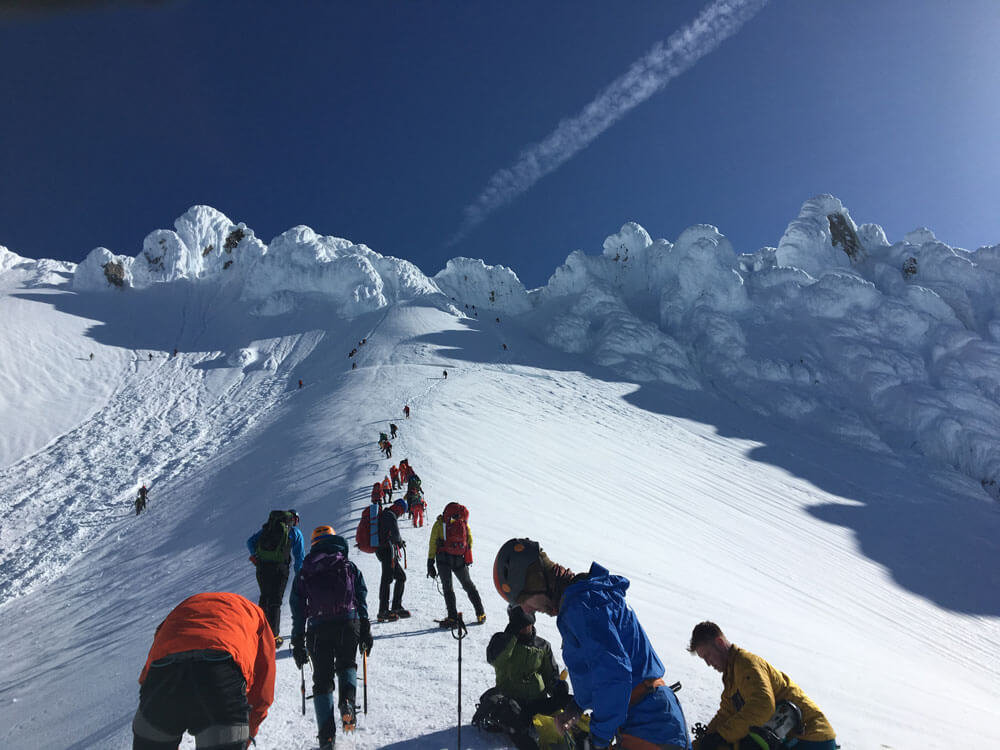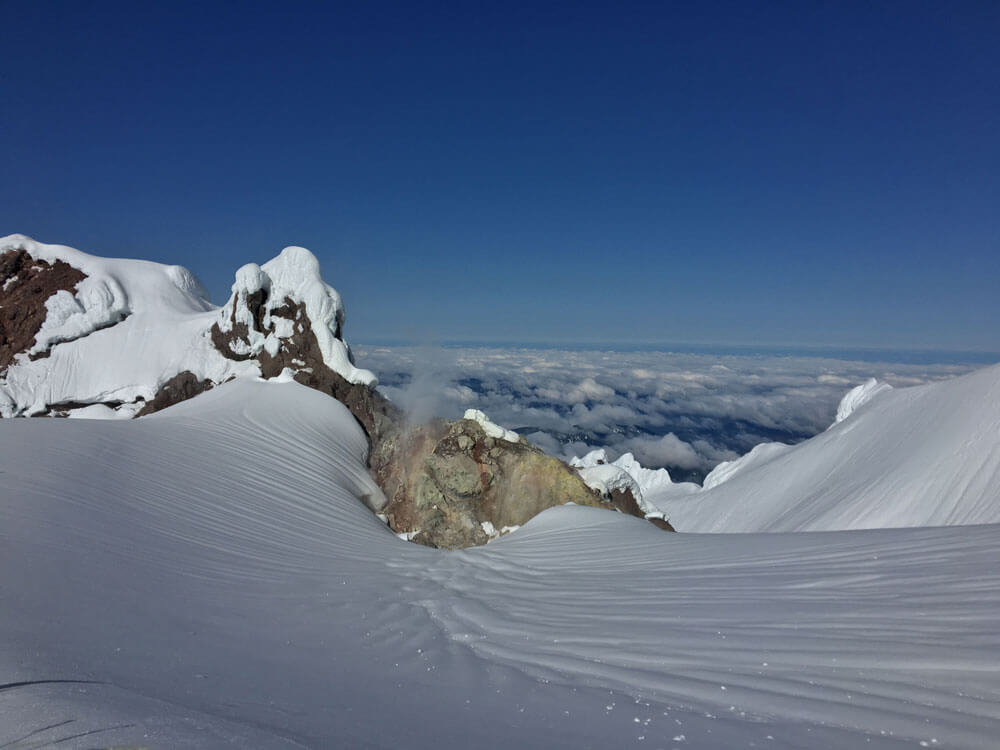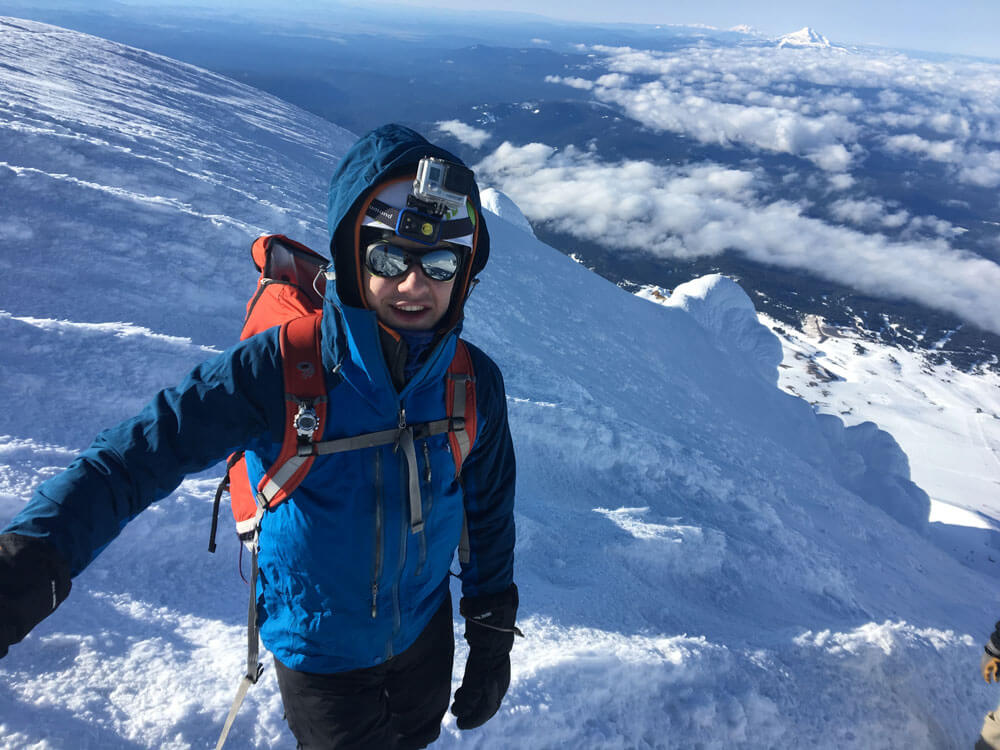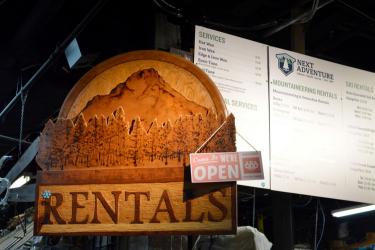
Trip Report: Mount Hood South Side Climb
When: 05/07/2017
Location: Mount Hood South Side
Conditions: Beautiful! Sunny and cold
Duration: 10 hours
Difficulty: Difficult
Kid Friendly: No
Pet Friendly: No
The Full Report:
Mount Hood is a climb that every aspiring alpinist should climb at least once, especially if you live in Portland, the city that it towers over. Climbers of all levels fill the peak’s chutes and cover its faces on every fair-weathered day between March and June. The South Side of Hood provides a challenging, technical, but fairly safe climb for climbers with limited, but some experience.
 It is essential that every climber be familiar with the use of an ice axe and crampons. This is an absolute must. It is irresponsible and poses a risk to other climbers to not know what you’re doing with your equipment (in 2002, a roped team of three fell and was unable to self-arrest. They pulled two other rope teams into the bergschrund, and two climbers died). The day we climbed, Sunday, May 7, a climber fell below the Pearly Gates and died because he didn’t self-arrest (his tool wasn’t in his hand). For those with some experience, Mt. Hood is a fantastic adventure.
We left Timberline Lodge (6000 ft.) at 1 am. Given that the temperatures fell to around 12 degrees that night and didn’t rise above 24 degrees the next day, it would have been safe to start much later. But the alpine start allowed us to avoid some of the crowds. In warmer weather, an early start is essential in order to be out of the chutes before the walls heat up and rock and ice begins to hail down. For two hours, we trudged up the climber’s trail, past Silcox hut, to the top of the Palmer Ski lift at 8500 feet. We took this part slow, partly due to the skis we were carrying. At the top of the Palmer lift, we put on crampons.
It is essential that every climber be familiar with the use of an ice axe and crampons. This is an absolute must. It is irresponsible and poses a risk to other climbers to not know what you’re doing with your equipment (in 2002, a roped team of three fell and was unable to self-arrest. They pulled two other rope teams into the bergschrund, and two climbers died). The day we climbed, Sunday, May 7, a climber fell below the Pearly Gates and died because he didn’t self-arrest (his tool wasn’t in his hand). For those with some experience, Mt. Hood is a fantastic adventure.
We left Timberline Lodge (6000 ft.) at 1 am. Given that the temperatures fell to around 12 degrees that night and didn’t rise above 24 degrees the next day, it would have been safe to start much later. But the alpine start allowed us to avoid some of the crowds. In warmer weather, an early start is essential in order to be out of the chutes before the walls heat up and rock and ice begins to hail down. For two hours, we trudged up the climber’s trail, past Silcox hut, to the top of the Palmer Ski lift at 8500 feet. We took this part slow, partly due to the skis we were carrying. At the top of the Palmer lift, we put on crampons.
 As we left Palmer, the large moon began to set, leaving us in a period of brief darkness, before the sun rose. The route continues up, to the East (climber’s right) of Crater Rock, at approximately 10,300 feet. We arrived at Crater Rock just as it was becoming light. We dropped our skis and started up to the saddle at the base of the Hog’s Back, which is the ridgeline running from Crater Rock almost to the summit.
There are two primary chutes to take when climbing the South Side route: The Old Chute and the Pearly Gates. The Old Chute lies west of the Hog’s Back. It’s fairly wide, steep, and has a lengthy steep runout—it is the safer option. The Pearly Gates are very narrow—only one maybe two climbers can be in them at a time—and they are very steep. Many people carry a second tool for this section. The Pearly Gates lie directly above the Hog’s Back. The fall line extends some 600 feet to the Devil’s Kitchen IF you miss the bergschrund. Depending on the time of year, it can be easy to fall straight into the bergschrund, an often fatal fall, if one doesn’t self-arrest.
As we left Palmer, the large moon began to set, leaving us in a period of brief darkness, before the sun rose. The route continues up, to the East (climber’s right) of Crater Rock, at approximately 10,300 feet. We arrived at Crater Rock just as it was becoming light. We dropped our skis and started up to the saddle at the base of the Hog’s Back, which is the ridgeline running from Crater Rock almost to the summit.
There are two primary chutes to take when climbing the South Side route: The Old Chute and the Pearly Gates. The Old Chute lies west of the Hog’s Back. It’s fairly wide, steep, and has a lengthy steep runout—it is the safer option. The Pearly Gates are very narrow—only one maybe two climbers can be in them at a time—and they are very steep. Many people carry a second tool for this section. The Pearly Gates lie directly above the Hog’s Back. The fall line extends some 600 feet to the Devil’s Kitchen IF you miss the bergschrund. Depending on the time of year, it can be easy to fall straight into the bergschrund, an often fatal fall, if one doesn’t self-arrest.
 Because of the bottleneck at the Pearly Gates and our lack of ropes, our party decided to head for the Old Chute. From the saddle at the base of the Hog’s Back, we headed west, under a few crevasses, crossing over an exposed bit of rock/mud at the vents. We were careful not to spend much time downwind of them, not only because they smell bad but because the gas can be poisonous. After starting up the face to the Old Chute, some of the newer climbers in our group said they would preferer to have pre-kicked steps. With this in mind, we began to traverse back to the Pearly Gates route, slightly above the elevation of the bergschrund. Climbers were going to the west of the gaping crevasses anyways, because the bridge across it had broken that morning.
Once back on route, we started up a line of steps to the west of the bergschrund. One newer climber in our group was having crampon trouble, and made the wise decision to turn around. Once we arrived at the headwall, we slowly managed our way across a scary and exposed traverse right, to the base of the Pearly Gates. We waited for three guided parties to descend the route, and slowly made our way up the steps in the gaps. Eventually the chute cleared, and we ascended the steep slope through the gates, and climbed the final stretch to a beautiful sunny summit, where we arrived at 7:50, 6 hours and 50 minutes after leaving the cars.
Because of the bottleneck at the Pearly Gates and our lack of ropes, our party decided to head for the Old Chute. From the saddle at the base of the Hog’s Back, we headed west, under a few crevasses, crossing over an exposed bit of rock/mud at the vents. We were careful not to spend much time downwind of them, not only because they smell bad but because the gas can be poisonous. After starting up the face to the Old Chute, some of the newer climbers in our group said they would preferer to have pre-kicked steps. With this in mind, we began to traverse back to the Pearly Gates route, slightly above the elevation of the bergschrund. Climbers were going to the west of the gaping crevasses anyways, because the bridge across it had broken that morning.
Once back on route, we started up a line of steps to the west of the bergschrund. One newer climber in our group was having crampon trouble, and made the wise decision to turn around. Once we arrived at the headwall, we slowly managed our way across a scary and exposed traverse right, to the base of the Pearly Gates. We waited for three guided parties to descend the route, and slowly made our way up the steps in the gaps. Eventually the chute cleared, and we ascended the steep slope through the gates, and climbed the final stretch to a beautiful sunny summit, where we arrived at 7:50, 6 hours and 50 minutes after leaving the cars.
 The exposed descent took a similar form as the ascent. Waiting for a clear break, we carefully stepped down the steep slopes. I felt comfortable enough to plunge step, though most people climbed with their bodies faced into the mountain. We passed several large groups headed up, and an enormous number of other climbers. We carefully skied the frozen-solid slope between Crater Rock and Palmer and enjoyed a delightful and quick descent from the top of Palmer.
Car to car, including about 20 minutes on the summit, the climb took us 9 hours and 38 minutes. We had an amazing weather window, perfect climbing conditions, and a smooth climb. If you’re going to climb Mt. Hood, make sure you’re prepared technically and physically, and that you know the route and the risks. Hood’s South Side is a wonderful climb and I think it’s something every climber in Oregon should do.
The exposed descent took a similar form as the ascent. Waiting for a clear break, we carefully stepped down the steep slopes. I felt comfortable enough to plunge step, though most people climbed with their bodies faced into the mountain. We passed several large groups headed up, and an enormous number of other climbers. We carefully skied the frozen-solid slope between Crater Rock and Palmer and enjoyed a delightful and quick descent from the top of Palmer.
Car to car, including about 20 minutes on the summit, the climb took us 9 hours and 38 minutes. We had an amazing weather window, perfect climbing conditions, and a smooth climb. If you’re going to climb Mt. Hood, make sure you’re prepared technically and physically, and that you know the route and the risks. Hood’s South Side is a wonderful climb and I think it’s something every climber in Oregon should do.
 It is essential that every climber be familiar with the use of an ice axe and crampons. This is an absolute must. It is irresponsible and poses a risk to other climbers to not know what you’re doing with your equipment (in 2002, a roped team of three fell and was unable to self-arrest. They pulled two other rope teams into the bergschrund, and two climbers died). The day we climbed, Sunday, May 7, a climber fell below the Pearly Gates and died because he didn’t self-arrest (his tool wasn’t in his hand). For those with some experience, Mt. Hood is a fantastic adventure.
We left Timberline Lodge (6000 ft.) at 1 am. Given that the temperatures fell to around 12 degrees that night and didn’t rise above 24 degrees the next day, it would have been safe to start much later. But the alpine start allowed us to avoid some of the crowds. In warmer weather, an early start is essential in order to be out of the chutes before the walls heat up and rock and ice begins to hail down. For two hours, we trudged up the climber’s trail, past Silcox hut, to the top of the Palmer Ski lift at 8500 feet. We took this part slow, partly due to the skis we were carrying. At the top of the Palmer lift, we put on crampons.
It is essential that every climber be familiar with the use of an ice axe and crampons. This is an absolute must. It is irresponsible and poses a risk to other climbers to not know what you’re doing with your equipment (in 2002, a roped team of three fell and was unable to self-arrest. They pulled two other rope teams into the bergschrund, and two climbers died). The day we climbed, Sunday, May 7, a climber fell below the Pearly Gates and died because he didn’t self-arrest (his tool wasn’t in his hand). For those with some experience, Mt. Hood is a fantastic adventure.
We left Timberline Lodge (6000 ft.) at 1 am. Given that the temperatures fell to around 12 degrees that night and didn’t rise above 24 degrees the next day, it would have been safe to start much later. But the alpine start allowed us to avoid some of the crowds. In warmer weather, an early start is essential in order to be out of the chutes before the walls heat up and rock and ice begins to hail down. For two hours, we trudged up the climber’s trail, past Silcox hut, to the top of the Palmer Ski lift at 8500 feet. We took this part slow, partly due to the skis we were carrying. At the top of the Palmer lift, we put on crampons.
 As we left Palmer, the large moon began to set, leaving us in a period of brief darkness, before the sun rose. The route continues up, to the East (climber’s right) of Crater Rock, at approximately 10,300 feet. We arrived at Crater Rock just as it was becoming light. We dropped our skis and started up to the saddle at the base of the Hog’s Back, which is the ridgeline running from Crater Rock almost to the summit.
There are two primary chutes to take when climbing the South Side route: The Old Chute and the Pearly Gates. The Old Chute lies west of the Hog’s Back. It’s fairly wide, steep, and has a lengthy steep runout—it is the safer option. The Pearly Gates are very narrow—only one maybe two climbers can be in them at a time—and they are very steep. Many people carry a second tool for this section. The Pearly Gates lie directly above the Hog’s Back. The fall line extends some 600 feet to the Devil’s Kitchen IF you miss the bergschrund. Depending on the time of year, it can be easy to fall straight into the bergschrund, an often fatal fall, if one doesn’t self-arrest.
As we left Palmer, the large moon began to set, leaving us in a period of brief darkness, before the sun rose. The route continues up, to the East (climber’s right) of Crater Rock, at approximately 10,300 feet. We arrived at Crater Rock just as it was becoming light. We dropped our skis and started up to the saddle at the base of the Hog’s Back, which is the ridgeline running from Crater Rock almost to the summit.
There are two primary chutes to take when climbing the South Side route: The Old Chute and the Pearly Gates. The Old Chute lies west of the Hog’s Back. It’s fairly wide, steep, and has a lengthy steep runout—it is the safer option. The Pearly Gates are very narrow—only one maybe two climbers can be in them at a time—and they are very steep. Many people carry a second tool for this section. The Pearly Gates lie directly above the Hog’s Back. The fall line extends some 600 feet to the Devil’s Kitchen IF you miss the bergschrund. Depending on the time of year, it can be easy to fall straight into the bergschrund, an often fatal fall, if one doesn’t self-arrest.
 Because of the bottleneck at the Pearly Gates and our lack of ropes, our party decided to head for the Old Chute. From the saddle at the base of the Hog’s Back, we headed west, under a few crevasses, crossing over an exposed bit of rock/mud at the vents. We were careful not to spend much time downwind of them, not only because they smell bad but because the gas can be poisonous. After starting up the face to the Old Chute, some of the newer climbers in our group said they would preferer to have pre-kicked steps. With this in mind, we began to traverse back to the Pearly Gates route, slightly above the elevation of the bergschrund. Climbers were going to the west of the gaping crevasses anyways, because the bridge across it had broken that morning.
Once back on route, we started up a line of steps to the west of the bergschrund. One newer climber in our group was having crampon trouble, and made the wise decision to turn around. Once we arrived at the headwall, we slowly managed our way across a scary and exposed traverse right, to the base of the Pearly Gates. We waited for three guided parties to descend the route, and slowly made our way up the steps in the gaps. Eventually the chute cleared, and we ascended the steep slope through the gates, and climbed the final stretch to a beautiful sunny summit, where we arrived at 7:50, 6 hours and 50 minutes after leaving the cars.
Because of the bottleneck at the Pearly Gates and our lack of ropes, our party decided to head for the Old Chute. From the saddle at the base of the Hog’s Back, we headed west, under a few crevasses, crossing over an exposed bit of rock/mud at the vents. We were careful not to spend much time downwind of them, not only because they smell bad but because the gas can be poisonous. After starting up the face to the Old Chute, some of the newer climbers in our group said they would preferer to have pre-kicked steps. With this in mind, we began to traverse back to the Pearly Gates route, slightly above the elevation of the bergschrund. Climbers were going to the west of the gaping crevasses anyways, because the bridge across it had broken that morning.
Once back on route, we started up a line of steps to the west of the bergschrund. One newer climber in our group was having crampon trouble, and made the wise decision to turn around. Once we arrived at the headwall, we slowly managed our way across a scary and exposed traverse right, to the base of the Pearly Gates. We waited for three guided parties to descend the route, and slowly made our way up the steps in the gaps. Eventually the chute cleared, and we ascended the steep slope through the gates, and climbed the final stretch to a beautiful sunny summit, where we arrived at 7:50, 6 hours and 50 minutes after leaving the cars.
 The exposed descent took a similar form as the ascent. Waiting for a clear break, we carefully stepped down the steep slopes. I felt comfortable enough to plunge step, though most people climbed with their bodies faced into the mountain. We passed several large groups headed up, and an enormous number of other climbers. We carefully skied the frozen-solid slope between Crater Rock and Palmer and enjoyed a delightful and quick descent from the top of Palmer.
Car to car, including about 20 minutes on the summit, the climb took us 9 hours and 38 minutes. We had an amazing weather window, perfect climbing conditions, and a smooth climb. If you’re going to climb Mt. Hood, make sure you’re prepared technically and physically, and that you know the route and the risks. Hood’s South Side is a wonderful climb and I think it’s something every climber in Oregon should do.
The exposed descent took a similar form as the ascent. Waiting for a clear break, we carefully stepped down the steep slopes. I felt comfortable enough to plunge step, though most people climbed with their bodies faced into the mountain. We passed several large groups headed up, and an enormous number of other climbers. We carefully skied the frozen-solid slope between Crater Rock and Palmer and enjoyed a delightful and quick descent from the top of Palmer.
Car to car, including about 20 minutes on the summit, the climb took us 9 hours and 38 minutes. We had an amazing weather window, perfect climbing conditions, and a smooth climb. If you’re going to climb Mt. Hood, make sure you’re prepared technically and physically, and that you know the route and the risks. Hood’s South Side is a wonderful climb and I think it’s something every climber in Oregon should do.

